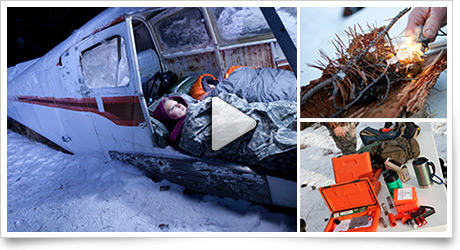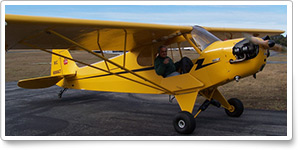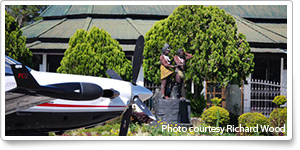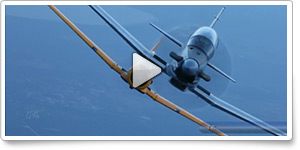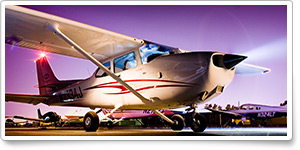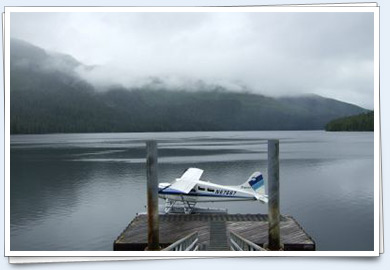|
||||||
|
After the accident, waiting for rescue |
|
|||||
|
Click here for this week's custom content. |
|
FeaturedAfter the accident, waiting for rescue
Fire and duct tape distress signals |
|
GA NewsMicron’s Appleton dies in Boise crashMicron Technology CEO Steve Appleton died in the crash of a Lancair IVP-TP airplane at the Boise, Idaho, airport Feb. 3. He was 51. Appleton was the sole occupant of the aircraft that crashed shortly after takeoff, said Patti Miller, spokesperson for the airport, who had just attended a National Transportation Safety Board briefing. According to Miller, Appleton had taxied the airplane from the Micron Technology company hangar, taken off, and returned once already that morning. Read more >>
|
||||||||||||||||||||||||||||||||||||||||||||
Flight Instructor Refresher Clinics |
Air Safety Institute Safety Seminars |
|||||||||
For a complete schedule, see AOPA Online. Can’t make it in person? Sign up for the CFI Refresher Online. |
Topics vary—for details and a complete schedule, see AOPA Online. |
|||||||||
ADVOCACY
Long-term FAA bill clears Congress, heads to president
The Senate, following up on recent House action, has passed a four-year, $63.4 billion FAA reauthorization bill with no user fees or fuel-tax increases. The bill, now headed to the desk of President Barack Obama for signing, would give the FAA its first long-term operating authority since 2007, ending a string of 23 stop-gap operating authorization measures. Read more >>
Graves: FAA bill protects GA
Keeping user fees out of the new FAA reauthorization bill was a "big win" for general aviation—but vigilance and education efforts must continue, said Rep. Sam Graves (R-Mo.), the House GA Caucus co-chairman and member of the conference committee that produced the final bill. In a statement, Graves highlighted favorable provisions for GA that he succeeded in inserting in the legislation. Read more >>
Fuller: Protect GPS from current, future threats
 A conditional approval of LightSquared’s use of the mobile satellite spectrum in 2011 put GPS signals at risk of dangerous interference—but Congress has the power to protect GPS from present and future threats, AOPA President Craig Fuller told a House subcommittee Feb. 8. The House Transportation and Infrastructure Committee's aviation subcommittee's hearing on the importance of GPS as a critical part of transportation infrastructure allowed Fuller to make recommendations on new protections that are needed to preserve the system's safety-critical role in the National Airspace System. Read more >>
A conditional approval of LightSquared’s use of the mobile satellite spectrum in 2011 put GPS signals at risk of dangerous interference—but Congress has the power to protect GPS from present and future threats, AOPA President Craig Fuller told a House subcommittee Feb. 8. The House Transportation and Infrastructure Committee's aviation subcommittee's hearing on the importance of GPS as a critical part of transportation infrastructure allowed Fuller to make recommendations on new protections that are needed to preserve the system's safety-critical role in the National Airspace System. Read more >>
AOPA urges changes to UAS-only airspace proposal
AOPA submitted several suggestions that would mitigate the impact of a proposed restricted airspace reserved for unmanned aircraft in North Dakota, but remains opposed to the creation of such an exclusive airspace. Implementation of the proposed restricted areas would create a disturbing precedent, carving out a slice of the finite National Airspace System for the operation of aircraft unable to "see and avoid" other traffic. Read more >>
FAA marks GPS approach milestone
A milestone for the nation's transition to satellite navigation was celebrated Feb. 9 in an FAA office in Silver Spring, Md.—and in cockpits equipped with WAAS around the country. The FAA AeroNav Products division published a new cycle of charts, including, for the first time, more than 3,000 satellite-based precision approaches. A total of 3,026 localizer performance with vertical guidance and localizer performance instrument approaches are now available to pilots. Read more >>
ADS-B traffic, weather now available in 51 terminal areas
 Real-time weather and traffic information is now available for free in dozens of terminal service areas around the country. Aircraft equipped with Automatic Dependent Surveillance-Broadcast (ADS-B) transceivers (and cockpit displays) can tap into the newly created data stream, part of the NextGen airspace modernization program. Flight Information System-Broadcast, or FIS-B, carries a full range of weather information including radar, pirep, METAR, TAF, and winds aloft data. Read more >>
Real-time weather and traffic information is now available for free in dozens of terminal service areas around the country. Aircraft equipped with Automatic Dependent Surveillance-Broadcast (ADS-B) transceivers (and cockpit displays) can tap into the newly created data stream, part of the NextGen airspace modernization program. Flight Information System-Broadcast, or FIS-B, carries a full range of weather information including radar, pirep, METAR, TAF, and winds aloft data. Read more >>
Recreational aviation gets stake in Forest Service planning
Recreational aviation and backcountry strips in US Forest Service lands recently received a much-needed lift. Forest Service planners must now consider aviation in their plans, whether it be preserving or maintaining backcountry strips. The agency released its preferred alternative to the US Forest Service Planning Rule, giving recreational aviation the same opportunities as activities that use land and water. Read more >>
FAA issues proposed rulemaking for Atlanta airspace
The FAA has issued a notice of proposed rulemaking to modify the Class B airspace in Atlanta. The agency maintains that reducing the diameter of the outer ring while lowering many interior shelves will save airline fuel, and enhance the efficiency of the world's busiest airspace. Comments will be accepted through April 3. Read more >>
Member Benefits
 Before you see the AME …
Before you see the AME …
There are numerous steps you can take to make your appointment with the aviation medical examiner go more smoothly, according to Dr. Jonathan Sackier. You can start with something as simple as scheduling your appointment early in the month that it's due to give yourself some time in the event something needs to be corrected. Read more in this selection from the Medical Services Program newsletter, available to members enrolled in the program.
Treat yourself this Valentine's Day at the AOPA Store
 The AOPA Store is chock-full of items that any pilot or aircraft owner would want. These are products that have been screened, tested, and approved by pilots to ensure that the AOPA logo is placed only on the highest quality merchandise. Stroll the virtual aisles of the AOPA Store and you'll find shirts, jackets, hats, wallets, watches, books, DVDs, training materials, and much more. The best thing, though, is that all of the items for sale in the AOPA Store are designed with the general aviation pilot in mind. Read more >>
The AOPA Store is chock-full of items that any pilot or aircraft owner would want. These are products that have been screened, tested, and approved by pilots to ensure that the AOPA logo is placed only on the highest quality merchandise. Stroll the virtual aisles of the AOPA Store and you'll find shirts, jackets, hats, wallets, watches, books, DVDs, training materials, and much more. The best thing, though, is that all of the items for sale in the AOPA Store are designed with the general aviation pilot in mind. Read more >>
AOPA Career Opportunities
Ever dream of turning your passion for aviation into a career? We’re looking for an online product manager, marketing specialist–products, aviation education program developer, accounting manager, chief flight instructor, manager of flight training programs, and associate editor–Web/ ePilot. To learn more about other AOPA career opportunities, visit AOPA Online.
Community
Picture PerfectAOPA’s online photo gallery allows you to upload your own aviation photography as well as view, rate, and comment on others’ photos. Your favorite aviation images from AOPA Pilot are still available online through this new gallery. Take a look, and submit your own photos! |
|
|
Rally GACheck out user-submitted events from your region. To include an event or to search all events in the calendar, visit AOPA Online. AOPA does not endorse the events listed below, nor have ePilot editors edited the submissions. AOPA assumes no responsibility for events listed. |
|
|
|
QUIZ ME!Here’s a question asked by an AOPA member who contacted our aviation services staff through the AOPA Pilot Information Center. Test your knowledge.
Question: I live in an area where we have numerous antennas, which have a variety of lights on them. I'm wondering why some lights are red while others are white. Sometimes they flash; sometimes they don't. Is there a rule that determines the color or type of lights on the antennas?
Answer: Any permanent or temporary structure, including all accessories, that exceeds an overall height of 200 feet agl or exceeds any obstruction standard contained in 14 CFR Part 77, should normally be marked and/or lighted. The lighting and marking of these obstructions is discussed in FAA Advisory Circular 70/7460-1K, “Obstruction Marking and Lighting.” There are too many variances of marking and lighting requirements to discuss here, but Chapters 2 through 4 provide the basic guidelines.
Got a question for our aviation services staff? The AOPA Pilot Information Center is a service available to all members as part of the annual dues. Call 800/USA-AOPA (800/872-2672), or email to [email protected]. |
|
|
|
|
|
|
| |
||||
| ePilot Editor: Sarah Brown | Contributors: Alyssa Miller Jim Moore Jill W. Tallman Warren Morningstar Alton K. Marsh |
|
Production Team: Melissa Whitehouse Siobhan Byrne Lezlie Ramsey Mitch Mitchell William Rockenbaugh |
Advertise in ePilot: |
|
Member Tools: Send feedback | ePilot Archive © 2012 Aircraft Owners and Pilots Association | 421 Aviation Way Frederick, MD 21701 | Phone 800/USA-AOPA | Fax 301/695-2375 |
||||




